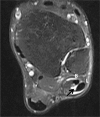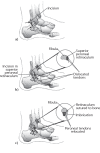Peroneal tendon disorders
- PMID: 28736620
- PMCID: PMC5508858
- DOI: 10.1302/2058-5241.2.160047
Peroneal tendon disorders
Abstract
Pathological abnormality of the peroneal tendons is an under-appreciated source of lateral hindfoot pain and dysfunction that can be difficult to distinguish from lateral ankle ligament injuries.Enclosed within the lateral compartment of the leg, the peroneal tendons are the primary evertors of the foot and function as lateral ankle stabilisers.Pathology of the tendons falls into three broad categories: tendinitis and tenosynovitis, tendon subluxation and dislocation, and tendon splits and tears. These can be associated with ankle instability, hindfoot deformity and anomalous anatomy such as a low lying peroneus brevis or peroneus quartus.A thorough clinical examination should include an assessment of foot type (cavus or planovalgus), palpation of the peronei in the retromalleolar groove on resisted ankle dorsiflexion and eversion as well as testing of lateral ankle ligaments.Imaging including radiographs, ultrasound and MRI will help determine the diagnosis. Treatment recommendations for these disorders are primarily based on case series and expert opinion.The aim of this review is to summarise the current understanding of the anatomy and diagnostic evaluation of the peroneal tendons, and to present both conservative and operative management options of peroneal tendon lesions. Cite this article: EFORT Open Rev 2017;2:281-292. DOI: 10.1302/2058-5241.2.160047.
Keywords: peroneal subluxation; peroneal tendinopathy; peroneal tendons; peroneus brevis; peroneus longus.
Conflict of interest statement
ICMJE Conflict of interest statement: P. O’Donnell reports that he receives royalties from a book published with Cambridge University Press.
Figures













References
-
- Dombek MF, Lamm BM, Saltrick K, Mendicino RW, Catanzariti AR. Peroneal tendon tears: a retrospective review. J Foot Ankle Surg 2003;42:250-258. - PubMed
-
- Maffulli N, Khan KM, Puddu G. Overuse tendon conditions: time to change a confusing terminology. Arthroscopy 1998;14:840-843. - PubMed
-
- Orthner E, Wagner M. Dislocation of the peroneal tendon. Sportverletz Sportschaden 1989;3:112-115. (In German) - PubMed
-
- Edwards M. The relations of the peroneal tendons to the fibula, calcaneus, and cuboideum. Am J Anat 1927;42:213-252.
-
- Mabit C, Salanne P, Boncoeur-Martel MP, et al. The lateral retromalleolar groove: a radio-anatomic study. Bull Assoc Anat (Nancy) 1996;80:17-21. (In French) - PubMed
Publication types
LinkOut - more resources
Full Text Sources
Other Literature Sources

